University Research Proposal: Tobacco Usage and Control Strategies
VerifiedAdded on 2020/03/16
|19
|3804
|34
Project
AI Summary
This research proposal investigates tobacco usage and control strategies, aiming to analyze current consumption patterns and evaluate the effectiveness of preventive measures. The proposal begins with an executive summary, followed by an introduction that outlines the project's objectives, scope, and a summary of relevant literature. It addresses key research questions regarding tobacco consumption, control strategies, and implementation effectiveness. The methodology section details both qualitative and quantitative research approaches, emphasizing reliability and validity. Data collection methods include interviews and questionnaires. The proposal also specifies variable specifications, instruments for data analysis, research limitations, and a time schedule. The research seeks to identify gaps in current strategies and recommend improvements for more effective tobacco control, ultimately contributing to public health initiatives. The literature review summarizes existing research, highlighting the adverse effects of tobacco and the importance of control strategies. The proposal aims to build a foundation of research in analyzing the field of tobacco usage and control strategies.

Running head: RESEARCH PROPOSAL
Research proposal
Name of the Student:
Name of the University:
Author note:
Research proposal
Name of the Student:
Name of the University:
Author note:
Paraphrase This Document
Need a fresh take? Get an instant paraphrase of this document with our AI Paraphraser
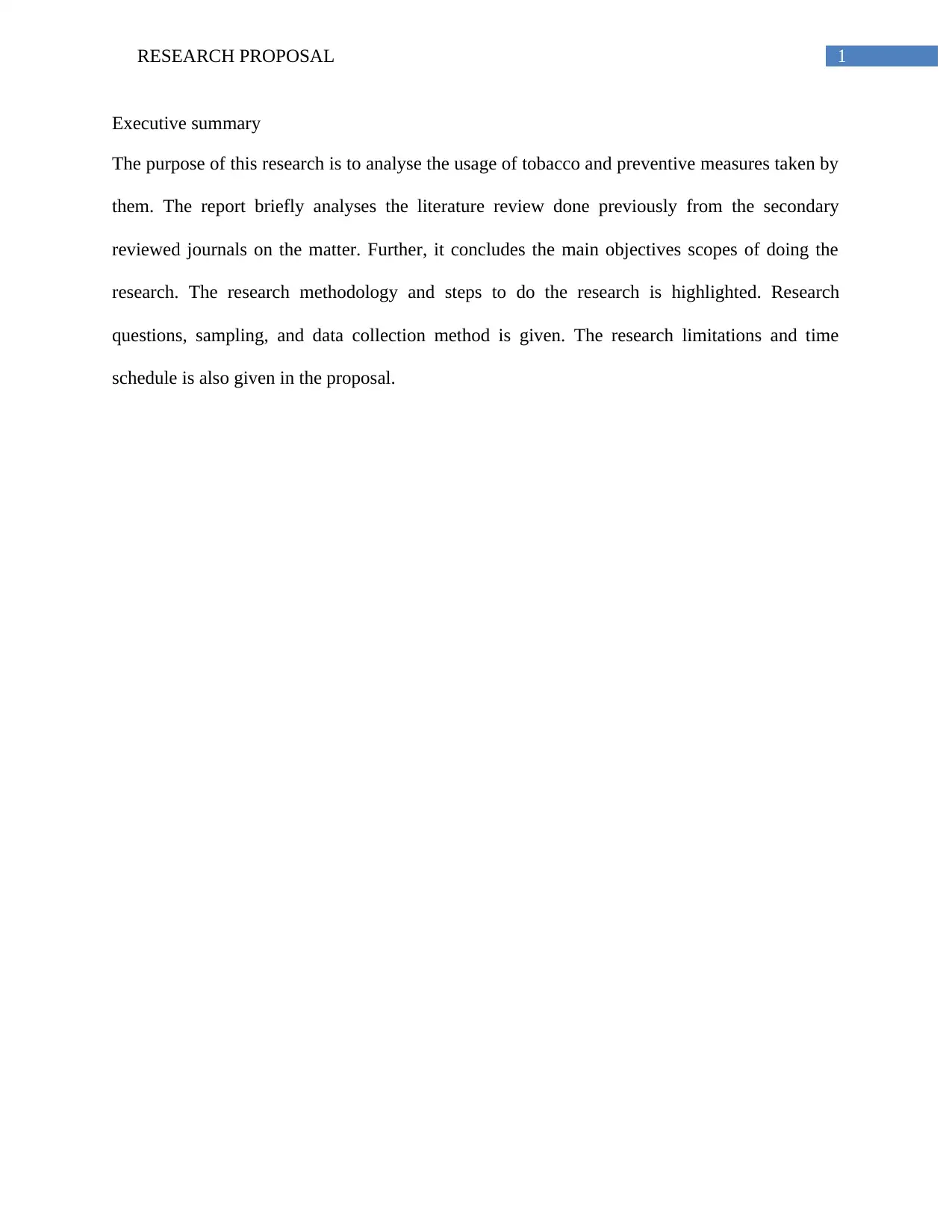
1RESEARCH PROPOSAL
Executive summary
The purpose of this research is to analyse the usage of tobacco and preventive measures taken by
them. The report briefly analyses the literature review done previously from the secondary
reviewed journals on the matter. Further, it concludes the main objectives scopes of doing the
research. The research methodology and steps to do the research is highlighted. Research
questions, sampling, and data collection method is given. The research limitations and time
schedule is also given in the proposal.
Executive summary
The purpose of this research is to analyse the usage of tobacco and preventive measures taken by
them. The report briefly analyses the literature review done previously from the secondary
reviewed journals on the matter. Further, it concludes the main objectives scopes of doing the
research. The research methodology and steps to do the research is highlighted. Research
questions, sampling, and data collection method is given. The research limitations and time
schedule is also given in the proposal.
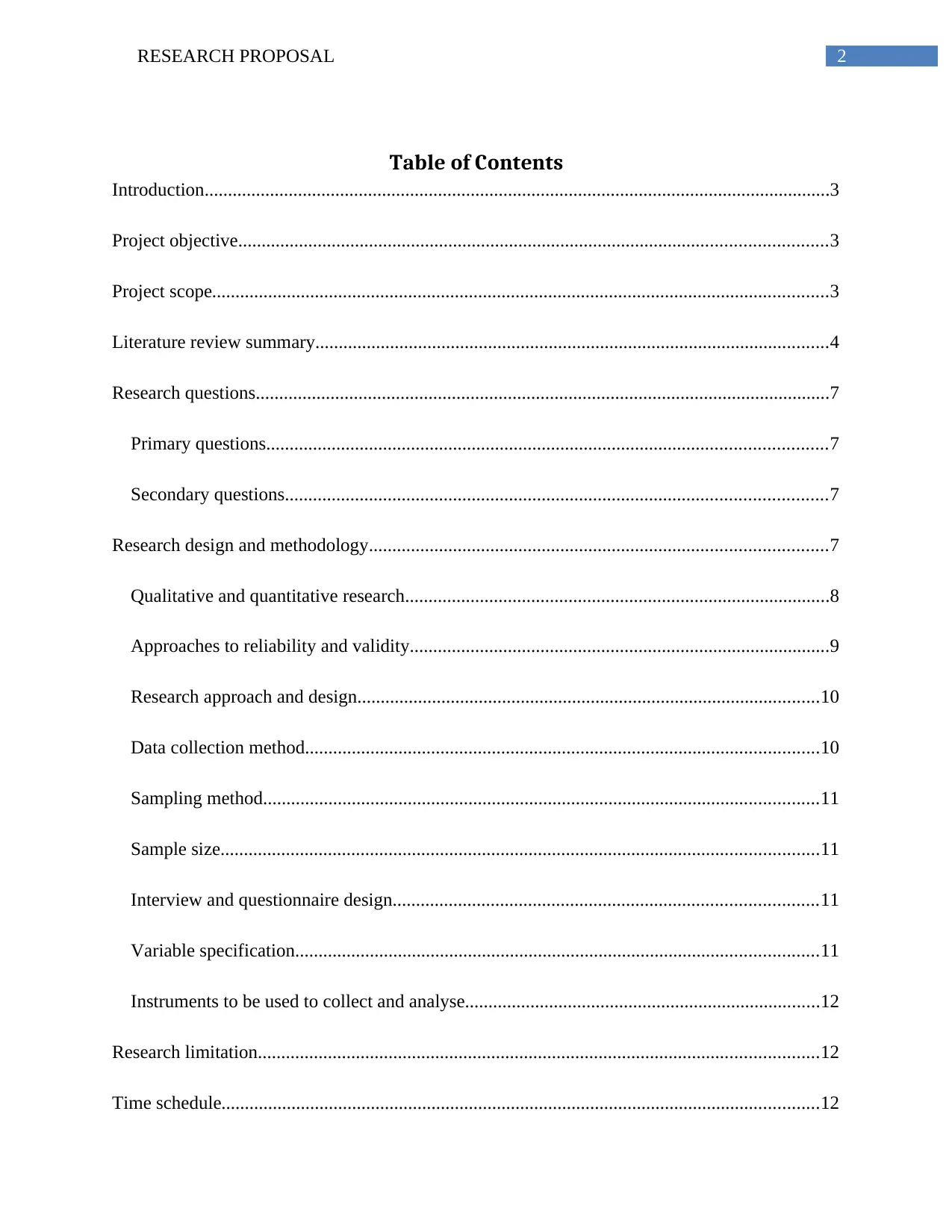
2RESEARCH PROPOSAL
Table of Contents
Introduction......................................................................................................................................3
Project objective..............................................................................................................................3
Project scope....................................................................................................................................3
Literature review summary..............................................................................................................4
Research questions...........................................................................................................................7
Primary questions........................................................................................................................7
Secondary questions....................................................................................................................7
Research design and methodology..................................................................................................7
Qualitative and quantitative research...........................................................................................8
Approaches to reliability and validity..........................................................................................9
Research approach and design...................................................................................................10
Data collection method..............................................................................................................10
Sampling method.......................................................................................................................11
Sample size................................................................................................................................11
Interview and questionnaire design...........................................................................................11
Variable specification................................................................................................................11
Instruments to be used to collect and analyse............................................................................12
Research limitation........................................................................................................................12
Time schedule................................................................................................................................12
Table of Contents
Introduction......................................................................................................................................3
Project objective..............................................................................................................................3
Project scope....................................................................................................................................3
Literature review summary..............................................................................................................4
Research questions...........................................................................................................................7
Primary questions........................................................................................................................7
Secondary questions....................................................................................................................7
Research design and methodology..................................................................................................7
Qualitative and quantitative research...........................................................................................8
Approaches to reliability and validity..........................................................................................9
Research approach and design...................................................................................................10
Data collection method..............................................................................................................10
Sampling method.......................................................................................................................11
Sample size................................................................................................................................11
Interview and questionnaire design...........................................................................................11
Variable specification................................................................................................................11
Instruments to be used to collect and analyse............................................................................12
Research limitation........................................................................................................................12
Time schedule................................................................................................................................12
⊘ This is a preview!⊘
Do you want full access?
Subscribe today to unlock all pages.

Trusted by 1+ million students worldwide
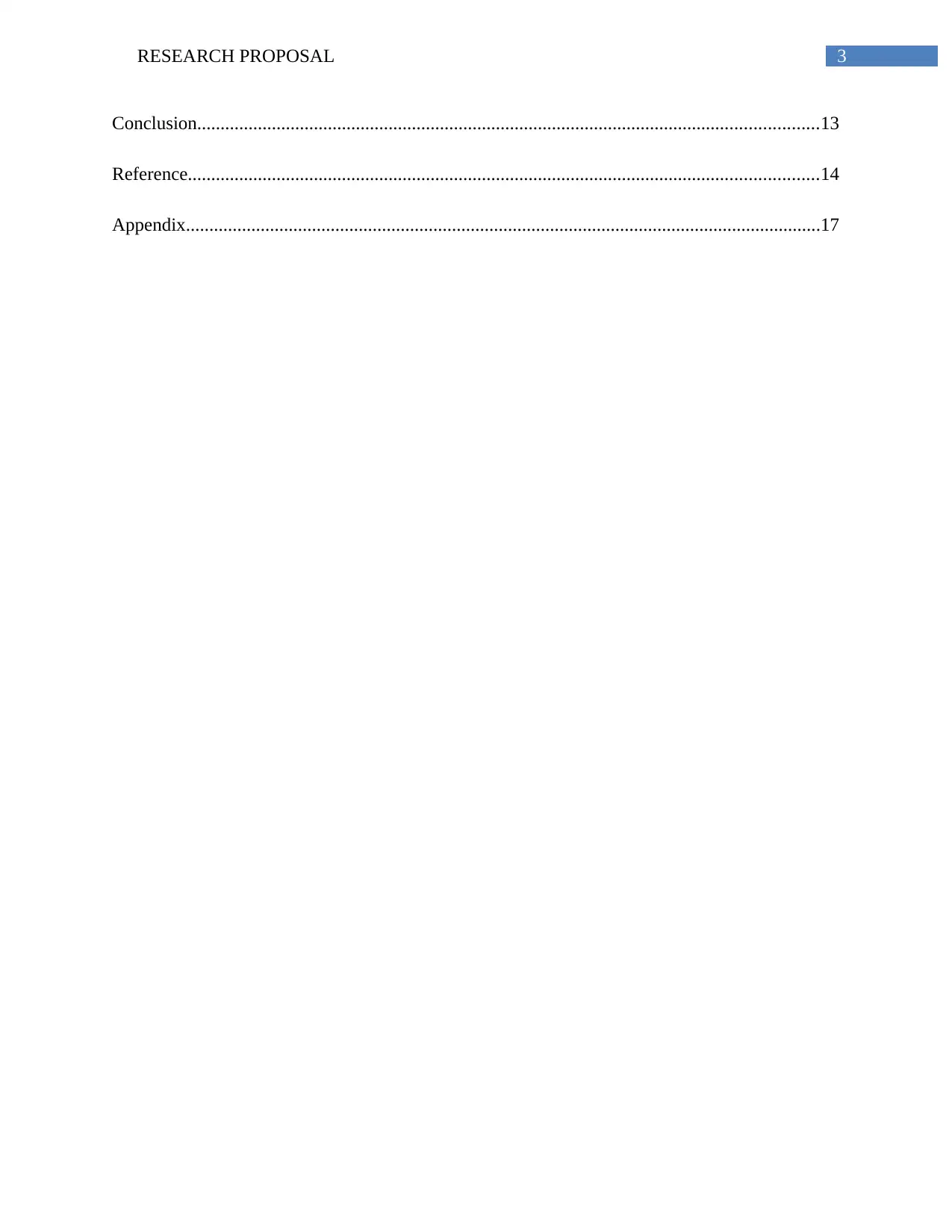
3RESEARCH PROPOSAL
Conclusion.....................................................................................................................................13
Reference.......................................................................................................................................14
Appendix........................................................................................................................................17
Conclusion.....................................................................................................................................13
Reference.......................................................................................................................................14
Appendix........................................................................................................................................17
Paraphrase This Document
Need a fresh take? Get an instant paraphrase of this document with our AI Paraphraser

4RESEARCH PROPOSAL
Introduction
The following is the research proposal in the usage of tobacco and control strategies that
can eradicate the problem from earth. The following research proposal contains a brief summary
of the literature review done previously and the control strategies and recommendation of
government campaigns. The objective and outline of the project is given. The consolidation of
the work that needs to be done according the time schedule is also given. The primary questions
and research methodology is thoroughly discussed. The steps that needs to be taken while doing
the research is given too (Golnick et al. 2016).
Project objective
The main objective of this project is
To build a foundation of research in the analysing the field of tobacco usage in different
demographic area
To analyse and highlight the control strategy of tobacco usage and its foul effect in
environment
To identify the effectiveness of the implementation strategies of barring the usage of
tobacco
To recommend the further improvement in the implementation strategies
Project scope
The main scope of the project is the discussion in the control and the implementation
strategy of reducing the usage of tobacco in different lifestyle of the population. The different
strategy and campaign that are used by the government in controlling the issue and how it have
Introduction
The following is the research proposal in the usage of tobacco and control strategies that
can eradicate the problem from earth. The following research proposal contains a brief summary
of the literature review done previously and the control strategies and recommendation of
government campaigns. The objective and outline of the project is given. The consolidation of
the work that needs to be done according the time schedule is also given. The primary questions
and research methodology is thoroughly discussed. The steps that needs to be taken while doing
the research is given too (Golnick et al. 2016).
Project objective
The main objective of this project is
To build a foundation of research in the analysing the field of tobacco usage in different
demographic area
To analyse and highlight the control strategy of tobacco usage and its foul effect in
environment
To identify the effectiveness of the implementation strategies of barring the usage of
tobacco
To recommend the further improvement in the implementation strategies
Project scope
The main scope of the project is the discussion in the control and the implementation
strategy of reducing the usage of tobacco in different lifestyle of the population. The different
strategy and campaign that are used by the government in controlling the issue and how it have

5RESEARCH PROPOSAL
been useful in eliminating the problem. The health of people all over the world is the major
concern of this prevention strategy. Initial issue will be identified as the consumption of tobacco
in different form and based on those different aspects of usage and the preventive strategies
implementation plan will be discussed. The emphasis in the eradication plan will be given.
Therefore, the control strategies will be discussed for further usage of research in the domain. In
addition, it will also be analysed about how much consciousness is there in the mind of the
adverse effect of tobacco consumption and what steps are taken in increasing the awareness (de
Silva et al. 2017).
Literature review summary
Tobacco usage has been a main issue of concern for government as well as the health
department all over the world. The extensive use of tobacco causes certain diseases that cannot
be eradicated easily. According the survey done previously, half million people all over the
world losses their lives from the harmful effect of tobacco. Even though the awareness spread
around the world, the major problems have also affected the world. The low price and reach
ability of all ages to the various object of tobacco is one of the main cause of diseases that hits
the general population. Not only the smokers but also the non-smokers are victim of the related
diseases (Greenland et al. 2016).
The use of tobacco has causes stimulation in different deadly diseases. The use of the
product starts early at the age of 18 years (World Health Organization 2015). Therefore, the habit
of smoking is continued until the later years of life. To curb the habit of smoking the youths must
be made aware and prevented from getting into the habit itself (Yong et al. 2015).
been useful in eliminating the problem. The health of people all over the world is the major
concern of this prevention strategy. Initial issue will be identified as the consumption of tobacco
in different form and based on those different aspects of usage and the preventive strategies
implementation plan will be discussed. The emphasis in the eradication plan will be given.
Therefore, the control strategies will be discussed for further usage of research in the domain. In
addition, it will also be analysed about how much consciousness is there in the mind of the
adverse effect of tobacco consumption and what steps are taken in increasing the awareness (de
Silva et al. 2017).
Literature review summary
Tobacco usage has been a main issue of concern for government as well as the health
department all over the world. The extensive use of tobacco causes certain diseases that cannot
be eradicated easily. According the survey done previously, half million people all over the
world losses their lives from the harmful effect of tobacco. Even though the awareness spread
around the world, the major problems have also affected the world. The low price and reach
ability of all ages to the various object of tobacco is one of the main cause of diseases that hits
the general population. Not only the smokers but also the non-smokers are victim of the related
diseases (Greenland et al. 2016).
The use of tobacco has causes stimulation in different deadly diseases. The use of the
product starts early at the age of 18 years (World Health Organization 2015). Therefore, the habit
of smoking is continued until the later years of life. To curb the habit of smoking the youths must
be made aware and prevented from getting into the habit itself (Yong et al. 2015).
⊘ This is a preview!⊘
Do you want full access?
Subscribe today to unlock all pages.

Trusted by 1+ million students worldwide
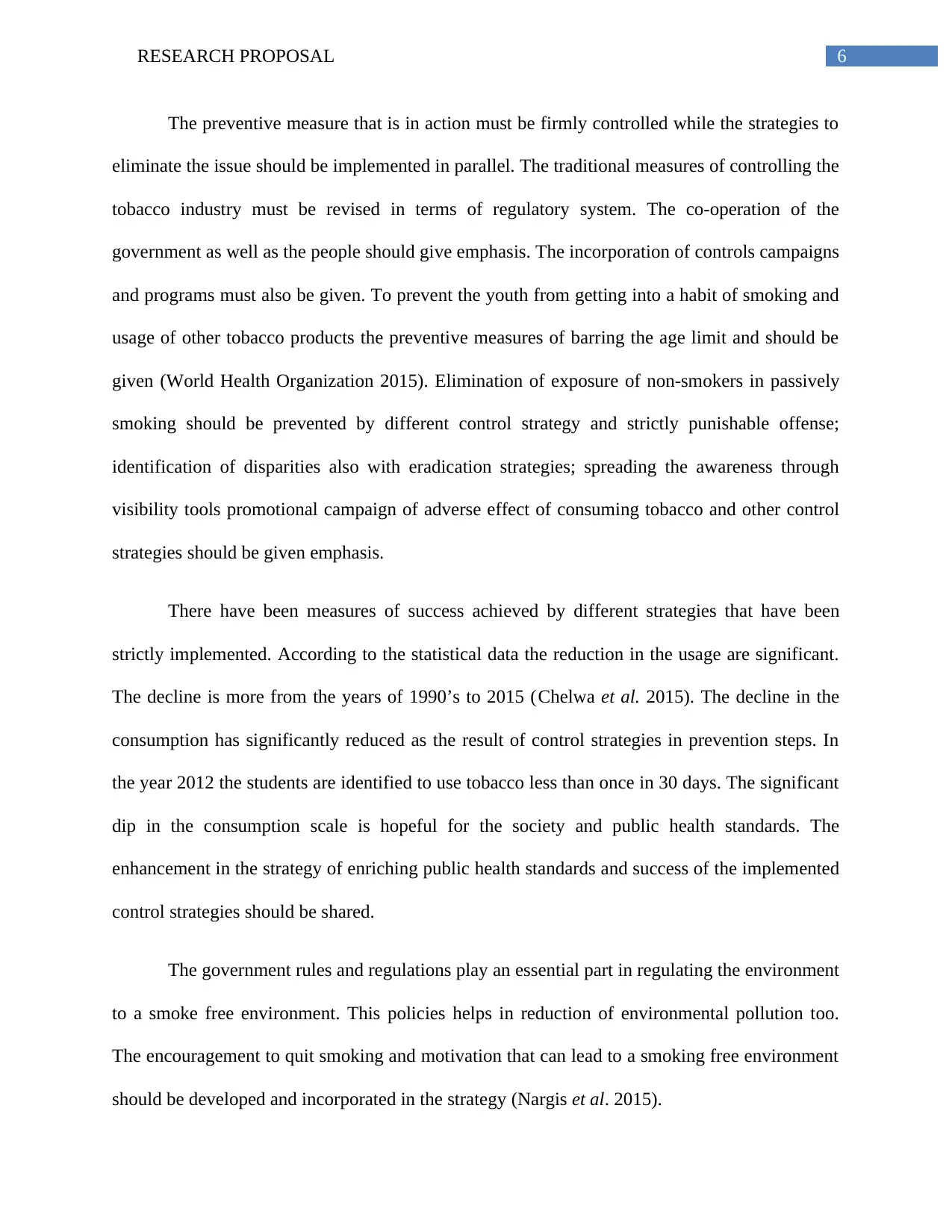
6RESEARCH PROPOSAL
The preventive measure that is in action must be firmly controlled while the strategies to
eliminate the issue should be implemented in parallel. The traditional measures of controlling the
tobacco industry must be revised in terms of regulatory system. The co-operation of the
government as well as the people should give emphasis. The incorporation of controls campaigns
and programs must also be given. To prevent the youth from getting into a habit of smoking and
usage of other tobacco products the preventive measures of barring the age limit and should be
given (World Health Organization 2015). Elimination of exposure of non-smokers in passively
smoking should be prevented by different control strategy and strictly punishable offense;
identification of disparities also with eradication strategies; spreading the awareness through
visibility tools promotional campaign of adverse effect of consuming tobacco and other control
strategies should be given emphasis.
There have been measures of success achieved by different strategies that have been
strictly implemented. According to the statistical data the reduction in the usage are significant.
The decline is more from the years of 1990’s to 2015 (Chelwa et al. 2015). The decline in the
consumption has significantly reduced as the result of control strategies in prevention steps. In
the year 2012 the students are identified to use tobacco less than once in 30 days. The significant
dip in the consumption scale is hopeful for the society and public health standards. The
enhancement in the strategy of enriching public health standards and success of the implemented
control strategies should be shared.
The government rules and regulations play an essential part in regulating the environment
to a smoke free environment. This policies helps in reduction of environmental pollution too.
The encouragement to quit smoking and motivation that can lead to a smoking free environment
should be developed and incorporated in the strategy (Nargis et al. 2015).
The preventive measure that is in action must be firmly controlled while the strategies to
eliminate the issue should be implemented in parallel. The traditional measures of controlling the
tobacco industry must be revised in terms of regulatory system. The co-operation of the
government as well as the people should give emphasis. The incorporation of controls campaigns
and programs must also be given. To prevent the youth from getting into a habit of smoking and
usage of other tobacco products the preventive measures of barring the age limit and should be
given (World Health Organization 2015). Elimination of exposure of non-smokers in passively
smoking should be prevented by different control strategy and strictly punishable offense;
identification of disparities also with eradication strategies; spreading the awareness through
visibility tools promotional campaign of adverse effect of consuming tobacco and other control
strategies should be given emphasis.
There have been measures of success achieved by different strategies that have been
strictly implemented. According to the statistical data the reduction in the usage are significant.
The decline is more from the years of 1990’s to 2015 (Chelwa et al. 2015). The decline in the
consumption has significantly reduced as the result of control strategies in prevention steps. In
the year 2012 the students are identified to use tobacco less than once in 30 days. The significant
dip in the consumption scale is hopeful for the society and public health standards. The
enhancement in the strategy of enriching public health standards and success of the implemented
control strategies should be shared.
The government rules and regulations play an essential part in regulating the environment
to a smoke free environment. This policies helps in reduction of environmental pollution too.
The encouragement to quit smoking and motivation that can lead to a smoking free environment
should be developed and incorporated in the strategy (Nargis et al. 2015).
Paraphrase This Document
Need a fresh take? Get an instant paraphrase of this document with our AI Paraphraser
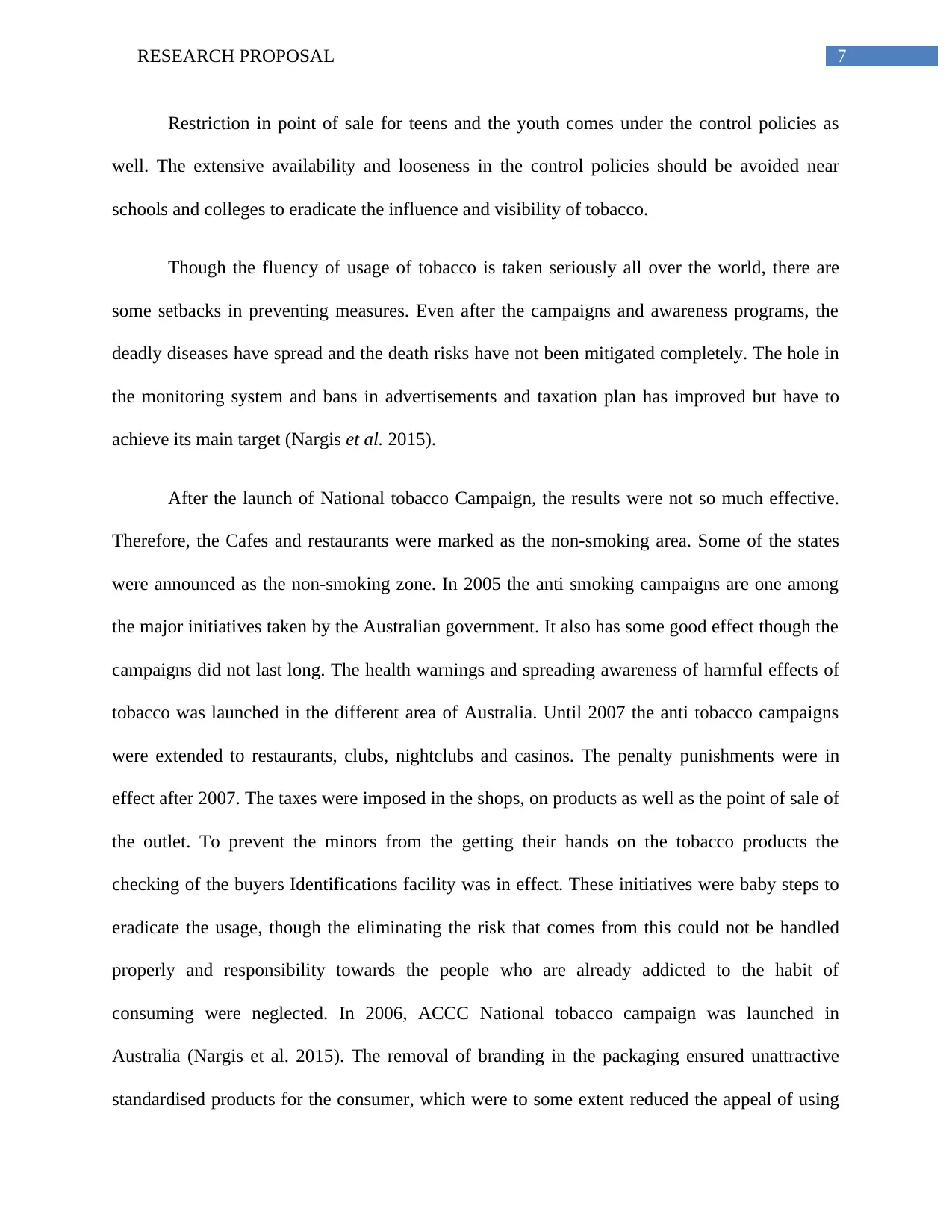
7RESEARCH PROPOSAL
Restriction in point of sale for teens and the youth comes under the control policies as
well. The extensive availability and looseness in the control policies should be avoided near
schools and colleges to eradicate the influence and visibility of tobacco.
Though the fluency of usage of tobacco is taken seriously all over the world, there are
some setbacks in preventing measures. Even after the campaigns and awareness programs, the
deadly diseases have spread and the death risks have not been mitigated completely. The hole in
the monitoring system and bans in advertisements and taxation plan has improved but have to
achieve its main target (Nargis et al. 2015).
After the launch of National tobacco Campaign, the results were not so much effective.
Therefore, the Cafes and restaurants were marked as the non-smoking area. Some of the states
were announced as the non-smoking zone. In 2005 the anti smoking campaigns are one among
the major initiatives taken by the Australian government. It also has some good effect though the
campaigns did not last long. The health warnings and spreading awareness of harmful effects of
tobacco was launched in the different area of Australia. Until 2007 the anti tobacco campaigns
were extended to restaurants, clubs, nightclubs and casinos. The penalty punishments were in
effect after 2007. The taxes were imposed in the shops, on products as well as the point of sale of
the outlet. To prevent the minors from the getting their hands on the tobacco products the
checking of the buyers Identifications facility was in effect. These initiatives were baby steps to
eradicate the usage, though the eliminating the risk that comes from this could not be handled
properly and responsibility towards the people who are already addicted to the habit of
consuming were neglected. In 2006, ACCC National tobacco campaign was launched in
Australia (Nargis et al. 2015). The removal of branding in the packaging ensured unattractive
standardised products for the consumer, which were to some extent reduced the appeal of using
Restriction in point of sale for teens and the youth comes under the control policies as
well. The extensive availability and looseness in the control policies should be avoided near
schools and colleges to eradicate the influence and visibility of tobacco.
Though the fluency of usage of tobacco is taken seriously all over the world, there are
some setbacks in preventing measures. Even after the campaigns and awareness programs, the
deadly diseases have spread and the death risks have not been mitigated completely. The hole in
the monitoring system and bans in advertisements and taxation plan has improved but have to
achieve its main target (Nargis et al. 2015).
After the launch of National tobacco Campaign, the results were not so much effective.
Therefore, the Cafes and restaurants were marked as the non-smoking area. Some of the states
were announced as the non-smoking zone. In 2005 the anti smoking campaigns are one among
the major initiatives taken by the Australian government. It also has some good effect though the
campaigns did not last long. The health warnings and spreading awareness of harmful effects of
tobacco was launched in the different area of Australia. Until 2007 the anti tobacco campaigns
were extended to restaurants, clubs, nightclubs and casinos. The penalty punishments were in
effect after 2007. The taxes were imposed in the shops, on products as well as the point of sale of
the outlet. To prevent the minors from the getting their hands on the tobacco products the
checking of the buyers Identifications facility was in effect. These initiatives were baby steps to
eradicate the usage, though the eliminating the risk that comes from this could not be handled
properly and responsibility towards the people who are already addicted to the habit of
consuming were neglected. In 2006, ACCC National tobacco campaign was launched in
Australia (Nargis et al. 2015). The removal of branding in the packaging ensured unattractive
standardised products for the consumer, which were to some extent reduced the appeal of using
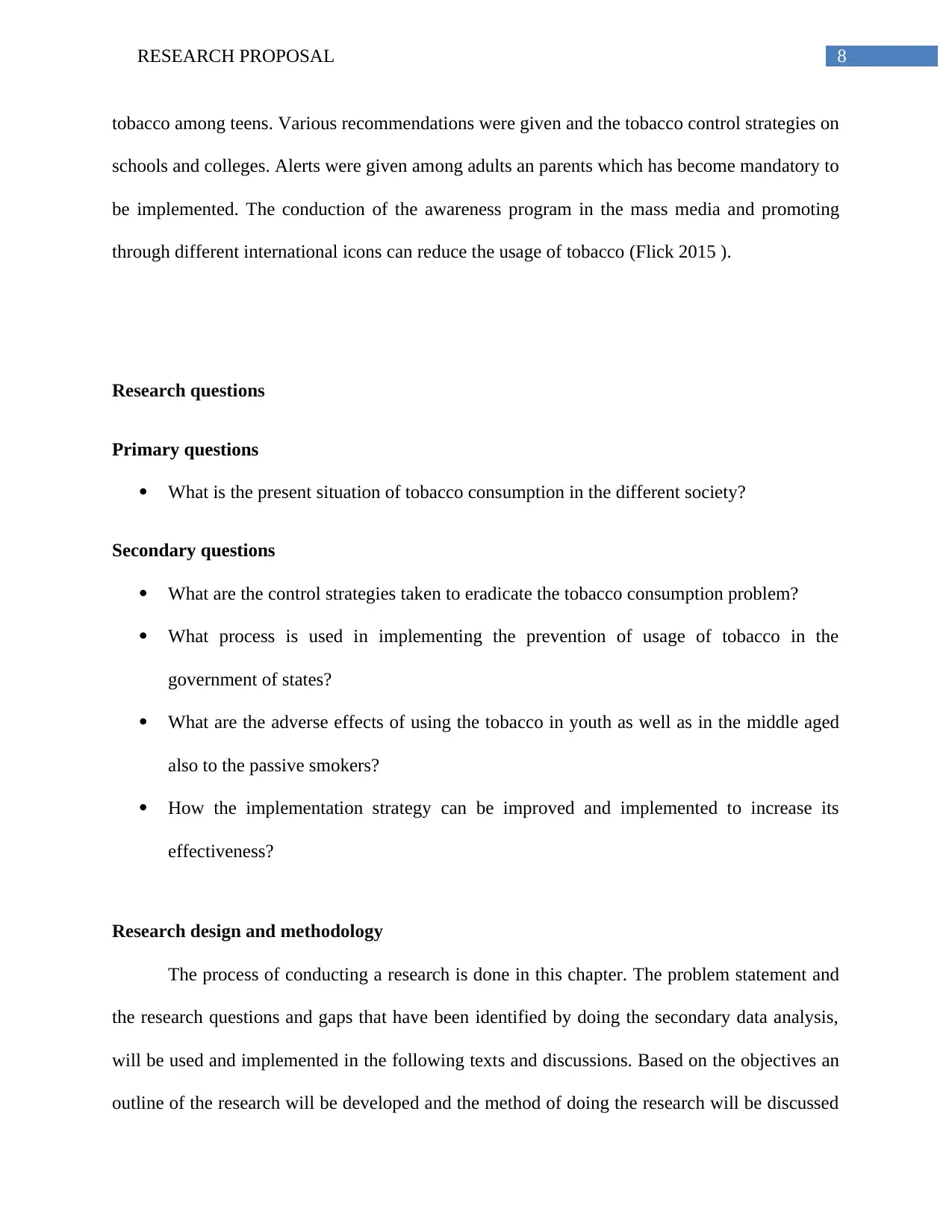
8RESEARCH PROPOSAL
tobacco among teens. Various recommendations were given and the tobacco control strategies on
schools and colleges. Alerts were given among adults an parents which has become mandatory to
be implemented. The conduction of the awareness program in the mass media and promoting
through different international icons can reduce the usage of tobacco (Flick 2015 ).
Research questions
Primary questions
What is the present situation of tobacco consumption in the different society?
Secondary questions
What are the control strategies taken to eradicate the tobacco consumption problem?
What process is used in implementing the prevention of usage of tobacco in the
government of states?
What are the adverse effects of using the tobacco in youth as well as in the middle aged
also to the passive smokers?
How the implementation strategy can be improved and implemented to increase its
effectiveness?
Research design and methodology
The process of conducting a research is done in this chapter. The problem statement and
the research questions and gaps that have been identified by doing the secondary data analysis,
will be used and implemented in the following texts and discussions. Based on the objectives an
outline of the research will be developed and the method of doing the research will be discussed
tobacco among teens. Various recommendations were given and the tobacco control strategies on
schools and colleges. Alerts were given among adults an parents which has become mandatory to
be implemented. The conduction of the awareness program in the mass media and promoting
through different international icons can reduce the usage of tobacco (Flick 2015 ).
Research questions
Primary questions
What is the present situation of tobacco consumption in the different society?
Secondary questions
What are the control strategies taken to eradicate the tobacco consumption problem?
What process is used in implementing the prevention of usage of tobacco in the
government of states?
What are the adverse effects of using the tobacco in youth as well as in the middle aged
also to the passive smokers?
How the implementation strategy can be improved and implemented to increase its
effectiveness?
Research design and methodology
The process of conducting a research is done in this chapter. The problem statement and
the research questions and gaps that have been identified by doing the secondary data analysis,
will be used and implemented in the following texts and discussions. Based on the objectives an
outline of the research will be developed and the method of doing the research will be discussed
⊘ This is a preview!⊘
Do you want full access?
Subscribe today to unlock all pages.

Trusted by 1+ million students worldwide
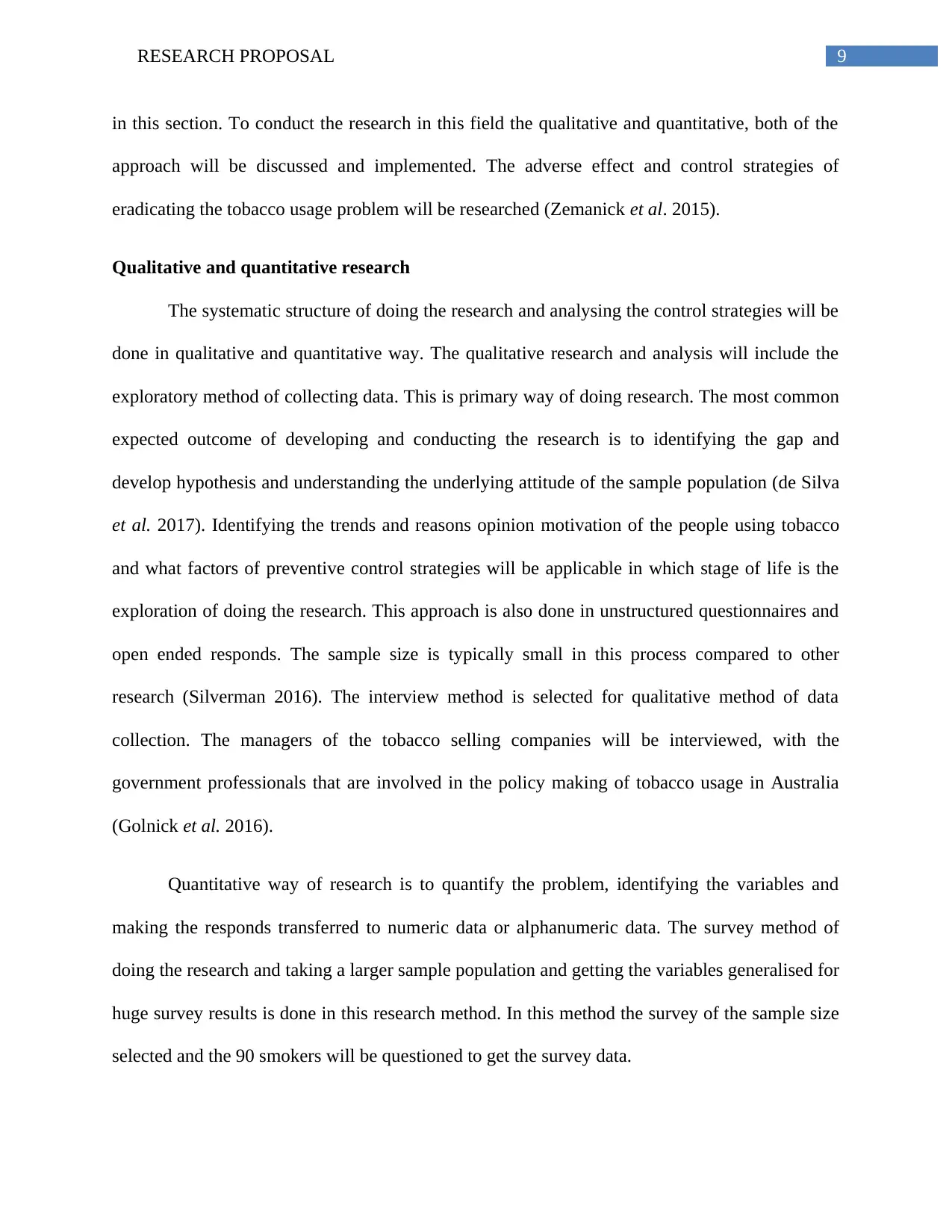
9RESEARCH PROPOSAL
in this section. To conduct the research in this field the qualitative and quantitative, both of the
approach will be discussed and implemented. The adverse effect and control strategies of
eradicating the tobacco usage problem will be researched (Zemanick et al. 2015).
Qualitative and quantitative research
The systematic structure of doing the research and analysing the control strategies will be
done in qualitative and quantitative way. The qualitative research and analysis will include the
exploratory method of collecting data. This is primary way of doing research. The most common
expected outcome of developing and conducting the research is to identifying the gap and
develop hypothesis and understanding the underlying attitude of the sample population (de Silva
et al. 2017). Identifying the trends and reasons opinion motivation of the people using tobacco
and what factors of preventive control strategies will be applicable in which stage of life is the
exploration of doing the research. This approach is also done in unstructured questionnaires and
open ended responds. The sample size is typically small in this process compared to other
research (Silverman 2016). The interview method is selected for qualitative method of data
collection. The managers of the tobacco selling companies will be interviewed, with the
government professionals that are involved in the policy making of tobacco usage in Australia
(Golnick et al. 2016).
Quantitative way of research is to quantify the problem, identifying the variables and
making the responds transferred to numeric data or alphanumeric data. The survey method of
doing the research and taking a larger sample population and getting the variables generalised for
huge survey results is done in this research method. In this method the survey of the sample size
selected and the 90 smokers will be questioned to get the survey data.
in this section. To conduct the research in this field the qualitative and quantitative, both of the
approach will be discussed and implemented. The adverse effect and control strategies of
eradicating the tobacco usage problem will be researched (Zemanick et al. 2015).
Qualitative and quantitative research
The systematic structure of doing the research and analysing the control strategies will be
done in qualitative and quantitative way. The qualitative research and analysis will include the
exploratory method of collecting data. This is primary way of doing research. The most common
expected outcome of developing and conducting the research is to identifying the gap and
develop hypothesis and understanding the underlying attitude of the sample population (de Silva
et al. 2017). Identifying the trends and reasons opinion motivation of the people using tobacco
and what factors of preventive control strategies will be applicable in which stage of life is the
exploration of doing the research. This approach is also done in unstructured questionnaires and
open ended responds. The sample size is typically small in this process compared to other
research (Silverman 2016). The interview method is selected for qualitative method of data
collection. The managers of the tobacco selling companies will be interviewed, with the
government professionals that are involved in the policy making of tobacco usage in Australia
(Golnick et al. 2016).
Quantitative way of research is to quantify the problem, identifying the variables and
making the responds transferred to numeric data or alphanumeric data. The survey method of
doing the research and taking a larger sample population and getting the variables generalised for
huge survey results is done in this research method. In this method the survey of the sample size
selected and the 90 smokers will be questioned to get the survey data.
Paraphrase This Document
Need a fresh take? Get an instant paraphrase of this document with our AI Paraphraser
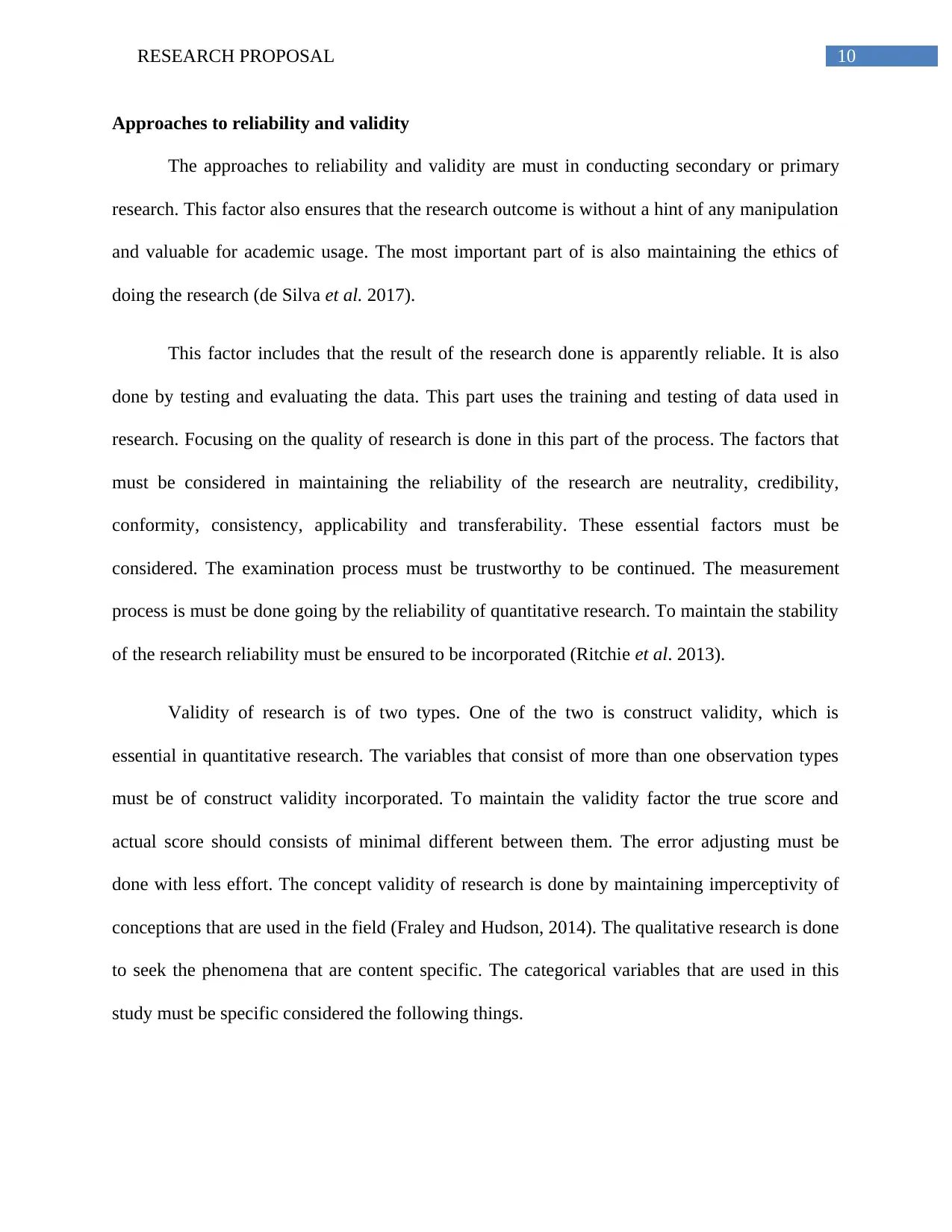
10RESEARCH PROPOSAL
Approaches to reliability and validity
The approaches to reliability and validity are must in conducting secondary or primary
research. This factor also ensures that the research outcome is without a hint of any manipulation
and valuable for academic usage. The most important part of is also maintaining the ethics of
doing the research (de Silva et al. 2017).
This factor includes that the result of the research done is apparently reliable. It is also
done by testing and evaluating the data. This part uses the training and testing of data used in
research. Focusing on the quality of research is done in this part of the process. The factors that
must be considered in maintaining the reliability of the research are neutrality, credibility,
conformity, consistency, applicability and transferability. These essential factors must be
considered. The examination process must be trustworthy to be continued. The measurement
process is must be done going by the reliability of quantitative research. To maintain the stability
of the research reliability must be ensured to be incorporated (Ritchie et al. 2013).
Validity of research is of two types. One of the two is construct validity, which is
essential in quantitative research. The variables that consist of more than one observation types
must be of construct validity incorporated. To maintain the validity factor the true score and
actual score should consists of minimal different between them. The error adjusting must be
done with less effort. The concept validity of research is done by maintaining imperceptivity of
conceptions that are used in the field (Fraley and Hudson, 2014). The qualitative research is done
to seek the phenomena that are content specific. The categorical variables that are used in this
study must be specific considered the following things.
Approaches to reliability and validity
The approaches to reliability and validity are must in conducting secondary or primary
research. This factor also ensures that the research outcome is without a hint of any manipulation
and valuable for academic usage. The most important part of is also maintaining the ethics of
doing the research (de Silva et al. 2017).
This factor includes that the result of the research done is apparently reliable. It is also
done by testing and evaluating the data. This part uses the training and testing of data used in
research. Focusing on the quality of research is done in this part of the process. The factors that
must be considered in maintaining the reliability of the research are neutrality, credibility,
conformity, consistency, applicability and transferability. These essential factors must be
considered. The examination process must be trustworthy to be continued. The measurement
process is must be done going by the reliability of quantitative research. To maintain the stability
of the research reliability must be ensured to be incorporated (Ritchie et al. 2013).
Validity of research is of two types. One of the two is construct validity, which is
essential in quantitative research. The variables that consist of more than one observation types
must be of construct validity incorporated. To maintain the validity factor the true score and
actual score should consists of minimal different between them. The error adjusting must be
done with less effort. The concept validity of research is done by maintaining imperceptivity of
conceptions that are used in the field (Fraley and Hudson, 2014). The qualitative research is done
to seek the phenomena that are content specific. The categorical variables that are used in this
study must be specific considered the following things.
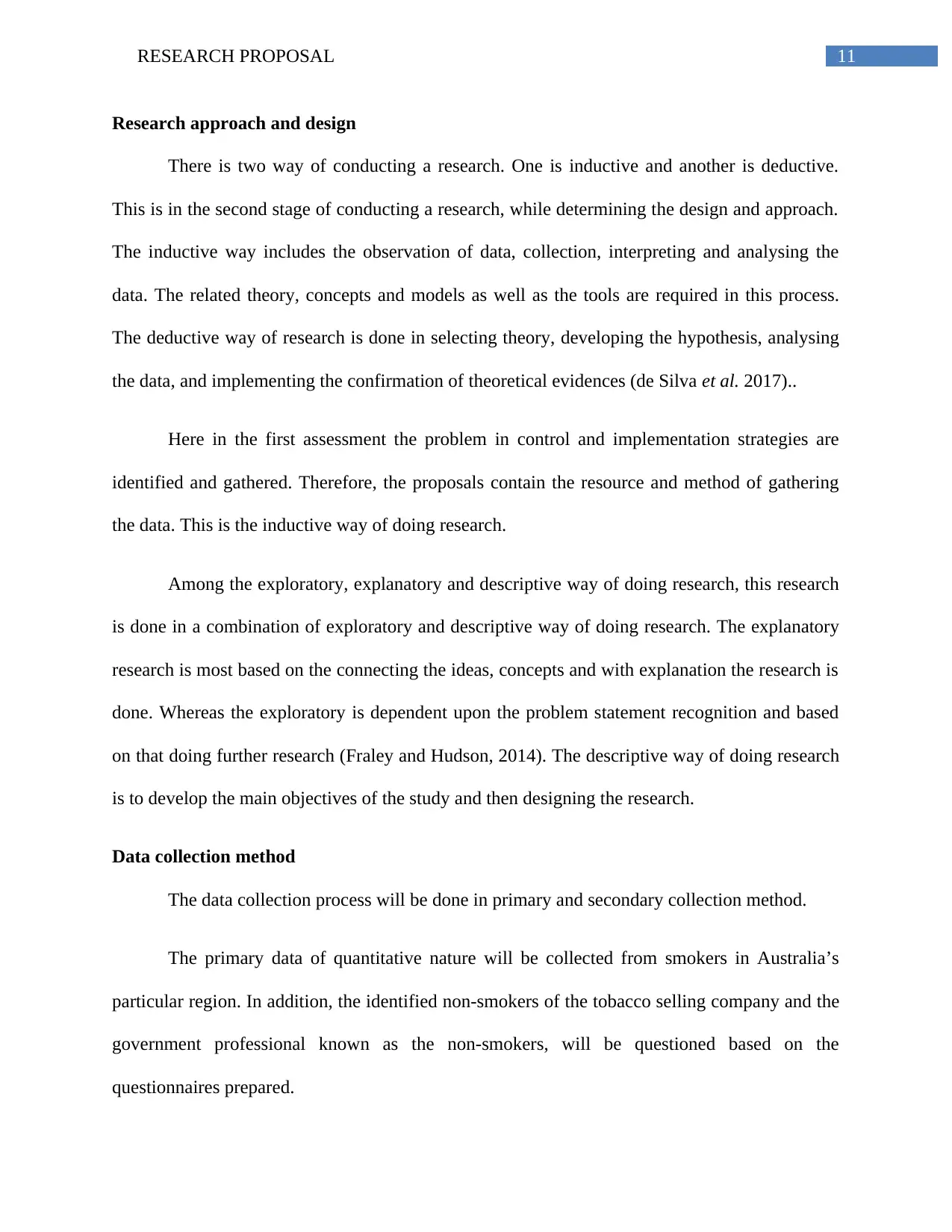
11RESEARCH PROPOSAL
Research approach and design
There is two way of conducting a research. One is inductive and another is deductive.
This is in the second stage of conducting a research, while determining the design and approach.
The inductive way includes the observation of data, collection, interpreting and analysing the
data. The related theory, concepts and models as well as the tools are required in this process.
The deductive way of research is done in selecting theory, developing the hypothesis, analysing
the data, and implementing the confirmation of theoretical evidences (de Silva et al. 2017)..
Here in the first assessment the problem in control and implementation strategies are
identified and gathered. Therefore, the proposals contain the resource and method of gathering
the data. This is the inductive way of doing research.
Among the exploratory, explanatory and descriptive way of doing research, this research
is done in a combination of exploratory and descriptive way of doing research. The explanatory
research is most based on the connecting the ideas, concepts and with explanation the research is
done. Whereas the exploratory is dependent upon the problem statement recognition and based
on that doing further research (Fraley and Hudson, 2014). The descriptive way of doing research
is to develop the main objectives of the study and then designing the research.
Data collection method
The data collection process will be done in primary and secondary collection method.
The primary data of quantitative nature will be collected from smokers in Australia’s
particular region. In addition, the identified non-smokers of the tobacco selling company and the
government professional known as the non-smokers, will be questioned based on the
questionnaires prepared.
Research approach and design
There is two way of conducting a research. One is inductive and another is deductive.
This is in the second stage of conducting a research, while determining the design and approach.
The inductive way includes the observation of data, collection, interpreting and analysing the
data. The related theory, concepts and models as well as the tools are required in this process.
The deductive way of research is done in selecting theory, developing the hypothesis, analysing
the data, and implementing the confirmation of theoretical evidences (de Silva et al. 2017)..
Here in the first assessment the problem in control and implementation strategies are
identified and gathered. Therefore, the proposals contain the resource and method of gathering
the data. This is the inductive way of doing research.
Among the exploratory, explanatory and descriptive way of doing research, this research
is done in a combination of exploratory and descriptive way of doing research. The explanatory
research is most based on the connecting the ideas, concepts and with explanation the research is
done. Whereas the exploratory is dependent upon the problem statement recognition and based
on that doing further research (Fraley and Hudson, 2014). The descriptive way of doing research
is to develop the main objectives of the study and then designing the research.
Data collection method
The data collection process will be done in primary and secondary collection method.
The primary data of quantitative nature will be collected from smokers in Australia’s
particular region. In addition, the identified non-smokers of the tobacco selling company and the
government professional known as the non-smokers, will be questioned based on the
questionnaires prepared.
⊘ This is a preview!⊘
Do you want full access?
Subscribe today to unlock all pages.

Trusted by 1+ million students worldwide
1 out of 19
Related Documents
Your All-in-One AI-Powered Toolkit for Academic Success.
+13062052269
info@desklib.com
Available 24*7 on WhatsApp / Email
![[object Object]](/_next/static/media/star-bottom.7253800d.svg)
Unlock your academic potential
Copyright © 2020–2025 A2Z Services. All Rights Reserved. Developed and managed by ZUCOL.





